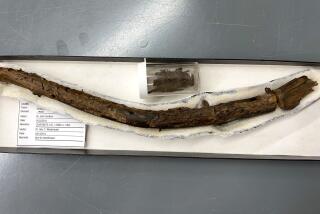Fossil Names Remain a Work in Progress
- Share via
Along with a state bird, butterfly, fish and tree, California boasts its own fossil, Smilodon californicus, or Californian saber-tooth cat.
Problem is, there was no such species.
Rather, there was once such an animal, skeletons of which have been found by the hundreds at the La Brea Tar Pits. But the name of the species was tossed out by scientists in the 1980s in favor of Smilodon fatalis.
For decades before then, paleontologists had attached the names to what they thought were two distinct species. They now believe they were one.
“The scientific name has changed, but it’s still the same animal,” said John Harris, chief curator of the Natural History Museum of Los Angeles County’s George C. Page Museum of La Brea Discoveries.
While the name S. californicus remains enshrined in California law--and, for the time being, on exhibit labels at the Tar Pits museum--it is considered an invalid name in paleontological databases of fossil North American mammal species.
Countless more bad names lurk within those databases, which tally the currently used names of the roughly 3,300 species of mammals known to have lived over the last 146 million years.
A single species can bear multiple names: S. fatalis has had as many as six. And sometimes multiple species are fixed with a single name. In other cases, the remains of female and male examples of a creature can be mistakenly dubbed as separate species.
The problem is hardly rare, or even unique to extinct mammals. The brontosaurus, for one, is properly known as the apatosaurus by dinosaur experts. Nor are the living exempt: the taxonomy of living insects is notoriously muddled.
But fossil remains can be particularly vexing, because not every species is preserved in the fossil record. When remains are found, they can be so fragmentary that scientists often have little more than a single tooth on which to base the identification of a new species.
As a consequence, the name game is in constant flux.
“We all know taxonomy is a work in progress, as all science is, and nobody thinks they know the final truth,” said Scott Wing, a research paleobiologist at the Smithsonian Institution’s National Museum of Natural History in Washington, D.C.
The naming errors have crept in, slowly and surely, ever since Sweden’s Carl Linnaeus began the modern system of classifying living things in the 1730s.
“Taxonomists aren’t gods, they’re people, so that’s the way it goes,” said John Alroy, a researcher at the National Center for Ecological Analysis and Synthesis at UC Santa Barbara.
Under the system, newly discovered species are given a binomial, or double, name in Latin. The first name refers to the genus of the species. The second typically refers to some attribute of either the species itself or the person who discovered it.
Nobody knows for certain how many invalid names there might be. Alroy has taken a stab at it, using a statistical model to estimate a whopping 24% to 30% of the total number of known fossil North American mammal species names are no good.
“The key thing is it’s a problem people ignore. But these are huge percentages,” said Alroy, who presented his results at a Geological Society of America meeting last fall.
The numbers are significant because they allow scientists to estimate patterns of biodiversity and extinction rates in the past--and how they might compare to those in the present, Alroy said.
Some experts dispute that so many names could prove invalid. Harris said he would estimate the amount to fall between 5% and 10%.
“I assume there has been some problem in the past, but people by and large strive for accuracy and truth. They’re not going out of their way to name new species,” Harris said.
When errors do crop up, the fixes do come but far more slowly than does the steady stream of new names. In May 1982, for example, two scientists, working independently, gave the same set of fossilized remains of a Miocene raccoon entirely different scientific names. The confusion took until 1989 to settle.
And just a few months ago, scientists at the Page Museum in Los Angeles quietly swapped out the label on their Mammuthus imperator, or Imperial mammoth, exhibit. The creature is now known as M. columbi, or the Columbian mammoth, which, again, had been thought to represent a distinct species.
“It’s not that new names are bad right off the bat; it’s that it takes time to catch them,” Alroy said.
Vetting the balance of the lists of fossil North American mammals could take 1,000 years, he said.
The final number of valid fossil species names, no matter how large, still pales in comparison to the ranks of now-extinct creatures that have yet to be discovered or described.
“We all know there’s a problem; it’s nice to know how big the problem is. But it’s still much less of a problem than what we don’t know yet,” Harris said.






